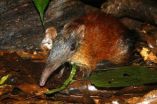(Press-News.org) Current WHO pesticide classifications are based on toxicity in rats but basing regulation on human toxicity will make pesticide poisoning less hazardous and prevent hundreds of thousands of deaths globally without compromising agricultural needs. These are the key findings from a study by Andrew Dawson (South Asian Clinical Toxicology Research Collaboration, University of Peradeniya, Sri Lanka) and colleagues published in this week's PLoS Medicine.
The single most common means of suicide worldwide is agricultural pesticide poisoning. The authors examined the proportion of patients dying (case fatality) of different agricultural pesticides among patients who presented with pesticide self-poisoning at two Sri Lankan referral hospitals. Between April 2002 and November 2008, 9,302 people were admitted to the hospitals after ingesting a single pesticide. The authors identified the pesticide ingested in 7,461 cases by asking the patient what he/she had taken or by identifying the container brought in by the patient or their relatives. Ten percent of the patients died but there was a large variation in case fatality between the pesticides taken. Compounds in the same chemical class and/or the same WHO toxicity class sometimes had very different toxicities. For example, dimethoate and malathione, both class II organophosphate insecticides, had case fatalities of 20.6% and 1.9%, respectively. Similarly, pesticides used for similar agricultural purposes sometimes had very different case fatalities.
These important findings are likely to be generalizable to other hospitals and to other parts of rural Asia as the systematically collected prospective human data enable reliable estimates of relative toxicity for pesticides.
The authors say that "the data are much more directly relevant to human risk assessment than the existing animal data from which the WHO/EPA classifications of toxicity used in regulation are derived." They continue: "Moreover, it provides evidence of very large differences in acute human toxicity within these widely used classifications. These data provide a basis for refining further public health, regulatory, and clinical responses to the problem of acute pesticide poisoning. "
In an accompanying Perspective on the research article, Matthew Miller and Kavi Bhalla from the Harvard School of Public Health, Boston, USA (uninvolved in the research), call for urgent reclassification of agricultural pesticides to help reduce suicides by pesticide poisoning.
They say: "The findings from the current study by Dawson and colleagues have helped refine human toxicity estimates for pesticides in use today. Better surveillance data and additional research will, eventually, lead to additional refinements. In the meantime, while we wait for these refinements, we must not ignore what, thanks to Dawson and colleagues, we already know."
INFORMATION:
Funding: This study was supported by the South Asian Clinical Toxicology Research Collaboration, which is funded by the Wellcome Trust/National Health and Medical Research Council International Collaborative Research Grant GR071669MA. The study sponsor had no role in study design, data collection, data analysis, data interpretation, or writing of the report.
Competing Interests: ME has received financial support to attend a scientific meeting of a study funded by Syngenta. NAB and AHD have received travel expenses from Syngenta (a manufacturer of paraquat and some other pesticides) to attend meetings of a scientific advisory group in relation to studies of new paraquat formulations.
Citation: Dawson AH, Eddleston M, Senarathna L, Mohamed F, Gawarammana I, et al. (2010) Acute Human Lethal Toxicity of Agricultural Pesticides: A Prospective Cohort Study. PLoS Med 7(10): e1000357. doi:10.1371/journal.pmed.1000357
IN YOUR COVERAGE PLEASE USE THIS URL TO PROVIDE ACCESS TO THE FREELY AVAILABLE PAPER: http://www.plosmedicine.org/article/info%3Adoi%2F10.1371%2Fjournal.pmed.1000357
PRESS-ONLY PREVIEW OF THE ARTICLE: www.plos.org/press/plme-07-10-dawson.pdf
CONTACT:
Andrew Dawson
South Asian Clinical Toxicology Research Collaboration (SACTRC)
Department of Clinical Medicine
University of Peradeniya
Peradeniya, 20000
Sri Lanka
+94773069606
adawson@sactrc.org
Related PLoS Medicine Perspective by Miller and colleagues:
Funding: The authors received no specific funding for this article.
Competing Interests: The authors have declared that no competing interests exist.
Citation: Miller M, Bhalla K (2010) An Urgent Need to Restrict Access to Pesticides Based on Human Lethality. PLoS Med 7(10): e1000358. doi:10.1371/journal.pmed.1000358
IN YOUR COVERAGE PLEASE USE THIS URL TO PROVIDE ACCESS TO THE FREELY AVAILABLE PAPER:
http://www.plosmedicine.org/article/info%3Adoi%2F10.1371%2Fjournal.pmed.1000358
PRESS-ONLY PREVIEW OF THE ARTICLE: http://www.plos.org/press/plme-07-10-miller.pdf
CONTACT: mmiller@hsph.harvard.edu
WHO pesticide regulations should be based on toxicity in humans, not rats
Press release from PLoS Medicine
2010-10-27
ELSE PRESS RELEASES FROM THIS DATE:
Nature's backbone at risk
2010-10-27
Nagoya, Japan, Wednesday 27 October 2010 (IUCN) – The most comprehensive assessment of the world's vertebrates confirms an extinction crisis with one-fifth of species threatened. However, the situation would be worse were it not for current global conservation efforts, according to a study launched today at the 10th Conference of the Parties to the Convention on Biological Diversity, CBD, in Nagoya, Japan.
The study, to be published in the international journal Science, used data for 25,000 species from The IUCN Red List of Threatened Species™, to investigate the status ...
World's vertebrates face increasing risk of extinction
2010-10-27
A new assessment conducted by 174 scientists from around the world underscores a growing concern about the health of the world's biodiversity, quantifying the rate of decline among vertebrate species on a global scale for the first time. The team's results support the idea that our planet is currently experiencing its sixth mass extinction—nearly one fifth of all known vertebrate species are currently classified as Threatened on the International Union for the Conservation of Nature (IUCN) Red List, and an average of 52 species of mammals, birds, and amphibians move one ...
Mosquito monitoring saves lives and money, analysis finds
2010-10-27
Cutting surveillance for mosquito-borne diseases would likely translate into an exponential increase in both the number of human cases and the health costs when a disease outbreak occurs, according to an analysis by Emory University.
The Public Library of Science (PLoS) publishes the research, led by Emory disease ecologist Gonzalo Vazquez-Prokopec, Oct. 26.
"Our analysis shows that halting mosquito surveillance can increase the management costs of epidemics by more than 300 times, in comparison with sustained surveillance and early case detection," Vazquez-Prokopec ...
New snub-nosed monkey discovered in Northern Myanmar
2010-10-27
An international team of primatologists have discovered a new species of monkey in Northern Myanmar (formerly Burma.) The research, published in the American Journal of Primatology, reveals how Rhinopithecus strykeri, a species of snub-nosed monkey, has an upturned nose which causes it to sneeze when it rains.
Field biologists led by Ngwe Lwin from the Myanmar Biodiversity And Nature Conservation Association and supported by an international team of primatologists from Fauna & Flora International (FFI) and the People Resources and Biodiversity Foundation, discovered the ...
Following lifestyle tips could prevent almost a quarter of bowel cancer cases
2010-10-27
Almost a quarter of colorectal (bowel) cancer cases could be prevented if people followed healthy lifestyle advice in five areas including diet and exercise, says a new study published on bmj.com today.
Researchers from Denmark found that following recommendations on physical activity, waist circumference, smoking, alcohol and diet could reduce the risk of developing bowel cancer considerably – by 23%.
Bowel cancer is the third most common cancer in the UK where more than 38,600 people are diagnosed with the condition every year. It is the second most common cause of ...
Year-long opiate substitution for drug misusers has 85 percent chance of cutting deaths
2010-10-27
Giving people opiate substitution treatment to help with their drug addiction can lead to a 85% plus chance of reducing mortality, according to a new study published on bmj.com today.
Researchers from Bristol and London found that the length of time people had opiate substitution treatment (OST) for had a large impact on its success and the likelihood of death.
Opiate users have a high risk of death, often from overdose.
OST, mostly methadone and buprenorphine, is central to prevention of drug related mortality and often delivered in primary care settings. Over the ...
Continuing biodiversity loss predicted but could be slowed
2010-10-27
A new analysis of several major global studies of future species shifts and losses foresees inevitable continuing decline of biodiversity during the 21st century but offers new hope that it could be slowed if emerging policy choices are pursued.
Led by experts Henrique Miguel Pereira and Paul Leadley, the 23-member scientific team from nine countries, under the auspices of DIVERSITAS, UNEP-WCMC and the secretariat of the CBD compared results from five recent global environmental assessments and a wide range of peer-reviewed literature examining likely future changes in ...
Extinction threat growing for vertebrates, researchers report in Science
2010-10-27
Increasing numbers of birds, mammals and amphibians have moved closer to extinction in the last several decades—but not as far as they would have if no conservation measures at all had been enacted, researchers report.
Their study is being published online by the journal Science, at the Science Express Web site, at 6:30 p.m., U.S. Eastern Time, Tuesday, 26 October. Science is the journal of AAAS, the nonprofit science society.
To assess the status of the world's vertebrates, a large, international research team lead by Michael Hoffmann of the International Union for ...
Scented consumer products shown to emit many unlisted chemicals
2010-10-27
The sweet smell of fresh laundry may contain a sour note. Widely used fragranced products – including those that claim to be "green" – give off many chemicals that are not listed on the label, including some that are classified as toxic.
A study led by the University of Washington discovered that 25 commonly used scented products emit an average of 17 chemicals each. Of the 133 different chemicals detected, nearly a quarter are classified as toxic or hazardous under at least one federal law. Only one emitted compound was listed on a product label, and only two were publicly ...
New insight into links between obesity and activity in the brain
2010-10-27
Scientists have revealed that an anti-obesity drug changes the way the brain responds to appetising, high-calorie foods in obese individuals. This insight may aid the development of new anti-obesity drugs which reduce the activity in the regions of the brain stimulated by the sight of tasty foods.
Researchers at the University of Cambridge discovered that the anti-obesity drug sibutramine reduced brain responses in two regions of the brain, the hypothalamus and the amygdala, both of which are known to be important in appetite control and eating behaviour. Their findings ...
LAST 30 PRESS RELEASES:
University of Oklahoma researcher awarded funding to pursue AI-powered material design
Exploring how the visual system recovers following injury
Support for parents with infants at pediatric check-ups leads to better reading and math skills in elementary school
Kids’ behavioral health is a growing share of family health costs
Day & night: Cancer disrupts the brain’s natural rhythm
COVID-19 vaccination significantly reduces risk to pregnant women and baby
The role of vaccination in maternal and perinatal outcomes associated with COVID-19 in pregnancy
Mayo Clinic smartwatch system helps parents shorten and defuse children's severe tantrums early
Behavioral health spending spikes to 40% of all children’s health expenditures, nearly doubling in a decade
Digital cognitive behavioral treatment for generalized anxiety disorder
Expenditures for pediatric behavioral health care over time and estimated family financial burden
Air conditioning in nursing homes and mortality during extreme heat
The Alps to lose a record number of glaciers in the next decade
What makes a good proton conductor?
New science reporting guide published for journalists in Bulgaria
New international study reveals major survival gaps among children with cancer
New science reporting guide published for journalists in Turkey
Scientists develop a smarter mRNA therapy that knows which cells to target
Neuroanatomy-informed brain–machine hybrid intelligence for robust acoustic target detection
Eight SwRI hydrogen projects funded by ENERGYWERX
The Lundquist Institute and its start-up company Vitalex Biosciences Announces Strategic Advancement of Second-Generation fungal Vaccine VXV-01 through Phase 1 Trials under $40 Million Competitive Con
Fine particles in pollution are associated with early signs of autoimmune disease
Review article | Towards a Global Ground-Based Earth Observatory (GGBEO): Leveraging existing systems and networks
Penn and UMich create world’s smallest programmable, autonomous robots
Cleveland researchers launch first major study to address ‘hidden performance killer’ in athletes
To connect across politics, try saying what you oppose
Modulating key interaction prevents virus from entering cells
Project explores barriers to NHS career progression facing international medical graduates
Jeonbuk National University researchers explore the impact of different seasonings on the flavor perception of Doenjang soup
Two Keck Medicine of USC Hospitals named Leapfrog Top Teaching Hospitals
[Press-News.org] WHO pesticide regulations should be based on toxicity in humans, not ratsPress release from PLoS Medicine


